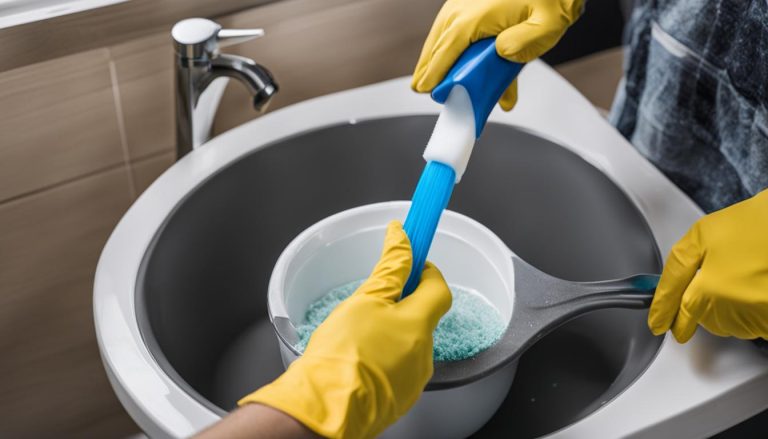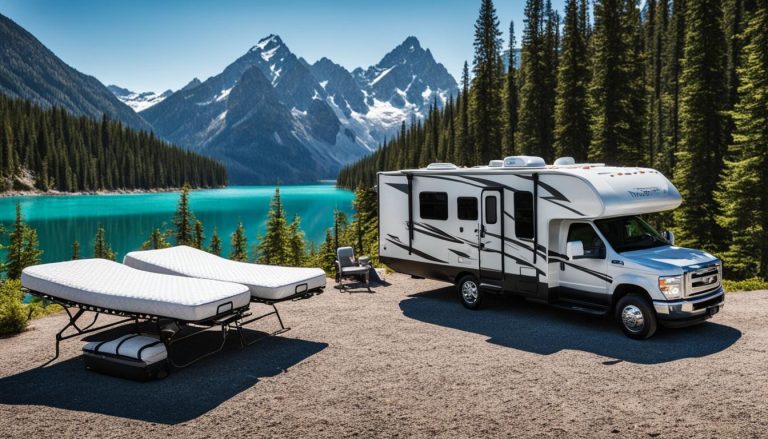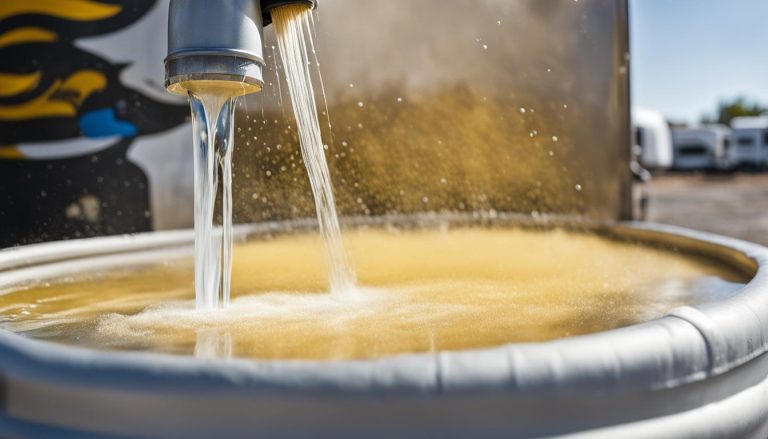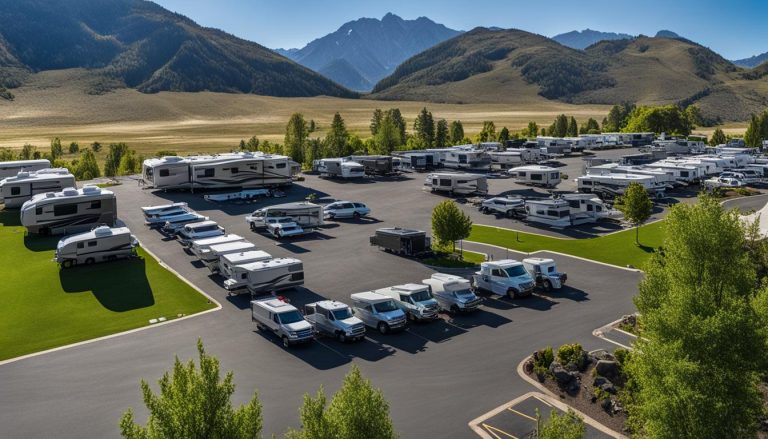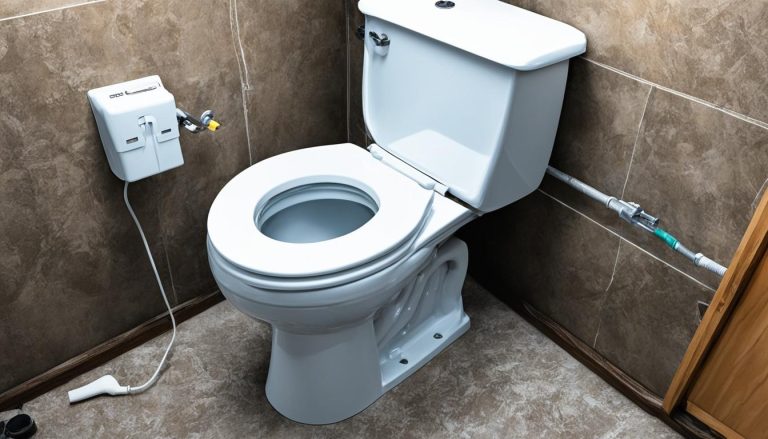Winter RV Guide: Keep Mice Out Effectively!
gorvlifestyle.com and its partners may earn a commission if you purchase a product through one of our links
Mice can cause significant damage to RVs during the winter months, making it essential to take preventative measures to keep them out. This comprehensive guide will provide you with effective methods to prevent mice from entering your RV and ensure a hassle-free winter season.
Key Takeaways:
- Inspect the exterior and interior of your RV for potential entry points.
- Seal off any cracks, holes, or openings using spray foam, caulk, or steel wool.
- Use mouse deterrents such as peppermint oil, dryer sheets, and Fresh Cab Rodent Repellent.
- Eliminate any “bridges” that may provide easy access for mice.
- Maintain cleanliness by regularly cleaning your RV and storing food in hard-sided bins.
How Mice Get In
Mice can be crafty creatures, finding their way into your RV through small holes and cracks. It’s important to understand how they gain access so you can take the necessary steps to prevent their entry. Even the tiniest openings can provide a gateway for mice. Here’s what you need to know:
Mice have collapsible rib cages, allowing them to squeeze through gaps as small as a dime.
Inspecting both the exterior and interior of your RV is crucial to identify potential entry points. Begin by examining the outside of your RV, paying close attention to any gaps or openings. Check for holes in the walls, gaps around windows and doors, and openings where utility pipes enter your RV. Mice are excellent climbers, so also inspect the roof, vents, and any areas where wiring or cables pass through.
Don’t forget to inspect the undercarriage of your RV as mice often enter from the ground.
Next, move inside your RV and carefully examine each room. Look for cracks in the flooring, holes in cabinets or storage areas, and gaps around pipes and wires that enter your RV. Mice can easily navigate through these small openings and make themselves at home.
Tip: Use a flashlight and brightly colored tape to mark potential entry points on the exterior of your RV. This will help you keep track of areas that need to be sealed off.
Once you’ve identified the entry points, it’s time to take action. Seal off all openings using appropriate materials. Spray foam, RV sealant or caulk, and steel wool are effective options. Remember to use steel wool for temporary closures during storage, as it can be easily removed when you’re ready to hit the road again.
| Potential Entry Points | Sealing Materials |
|---|---|
| Wall gaps and holes | Spray foam, RV sealant, caulk |
| Window and door gaps | RV sealant, caulk |
| Utility pipe openings | Spray foam, steel wool |
| Floor cracks and holes | Spray foam, RV sealant, caulk |
| Wall cabinet gaps | Steel wool |
By thoroughly inspecting your RV and sealing off potential entry points, you can significantly reduce the risk of a rodent infestation during the winter months. Taking these proactive measures will help keep mice at bay and ensure a stress-free and pest-free experience on your RV adventures.
Scouring the Exterior for Entry Points
When it comes to winterizing your RV to keep mice out, one of the essential tasks is to scour the exterior for potential entry points. Mice can squeeze through even the tiniest cracks and holes, so a thorough inspection is necessary to identify and seal off these openings.
Start by gathering a flashlight and brightly colored tape. With these tools in hand, you’ll be able to mark potential entry points as you find them. Be sure to pay close attention to the ground area, as mice often enter through gaps in the underbelly of your RV.
Before you begin your inspection, it’s important to take proper safety precautions. Crawling under your RV can be challenging, so make sure you have enough room to maneuver safely. Consider using knee pads and protective gloves to prevent any injuries.
As you carefully inspect your RV’s exterior, keep an eye out for any holes or cracks that could serve as potential entry points for mice. Once you’ve identified these areas, it’s time to seal them off using appropriate materials.
You have several options for sealing off the holes and cracks. Spray foam is an excellent choice for larger openings, as it expands to fill the gaps effectively. RV sealant or caulk can be used for smaller cracks and crevices. For temporary closures during storage, steel wool can provide a barrier that mice cannot chew through.
To sum it up:
- Gather a flashlight and brightly colored tape for the inspection.
- Pay special attention to the ground area where mice often enter.
- Take safety precautions when crawling under your RV.
- Identify potential entry points and mark them with tape.
- Seal off the holes and cracks using spray foam, RV sealant or caulk, or steel wool.
By thoroughly scouring the exterior of your RV for entry points and taking appropriate measures to seal them off, you’ll significantly reduce the chances of a mouse infestation during the winter months.
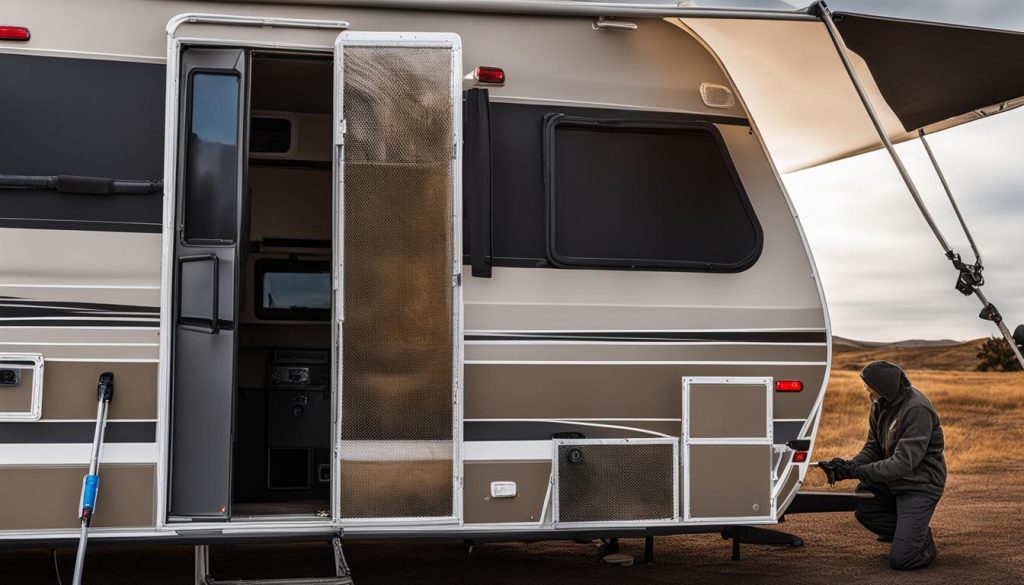
Using Mouse Deterrents
Make your RV unattractive to mice by using effective methods to prevent mice in RV during winter. There are various mouse deterrents that you can use to keep these unwanted guests away from your RV. The following are some popular options:
- Peppermint oil: Soak cotton balls in peppermint oil or use peppermint oil spray to keep mice away. The strong scent of peppermint is known to repel mice.
- Dryer sheets: Place dryer sheets in areas that mice can access. The strong odor of dryer sheets can deter mice from entering your RV.
- Mothballs: Similar to dryer sheets, placing mothballs in strategic locations can help keep mice away. Be cautious when using mothballs as they can be toxic to humans and pets.
- Fresh Cab Rodent Repellent: Fresh Cab is a natural rodent repellent that combines balsam fir oil and other plant-based ingredients. It is effective at deterring mice and can be placed in areas where mice are likely to enter.
It’s important to note that fragranced repellents may lose their effectiveness over time and need to be replaced regularly. Therefore, it’s recommended to monitor and refresh these deterrents periodically to ensure they remain effective.
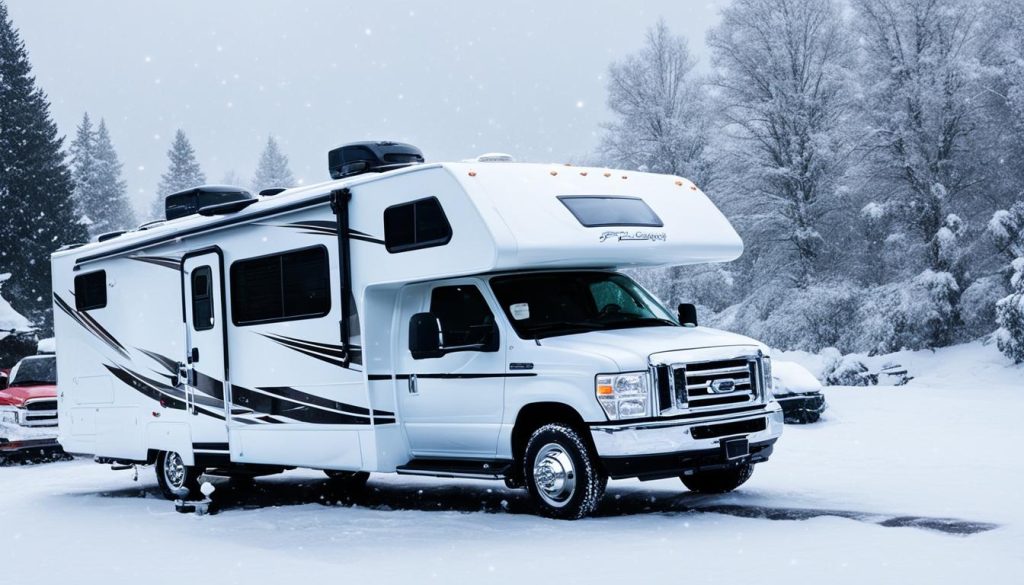
Expert Tip:
“When using peppermint oil, make sure to reapply it every few weeks or as needed, as the scent diminishes over time. This will help maintain its deterrent effect on mice.”
By employing mouse deterrents, you can significantly reduce the chances of mice finding their way into your RV during the winter season. These simple yet effective methods can help keep your RV mouse-free and protect it from potential damage caused by rodents.
Burning All Bridges
Mice prefer to climb rather than jump, so it is crucial to eliminate any “bridges” that give them easy access to your RV. This includes hanging tubes or your tires. Take proactive measures to prevent mice from climbing up your RV and entering through these pathways.
Securing Your Tires
To prevent mice from using your tires as an entry point, wrap sheet metal around them. This creates a barrier and makes it difficult for mice to climb up.
Removing Hanging Tubes or Pathways
Inspect your RV for any hanging tubes, ropes, or other potential pathways that mice can use to enter from the ground. These can serve as easy access points, so it is important to remove them.
“Preventive measures like removing any hanging structures or pathways can go a long way in keeping mice out of your RV during the winter.”
By taking these steps, you can significantly reduce the risk of rodent infestation in your RV during the winter months.
Keeping Things Clean
Maintaining cleanliness is crucial to keeping mice away from your RV. By following these winter RV mouse control tips and practicing effective rodent prevention for wintering RV, you can create an environment that is unappealing to mice and minimize the risk of infestation.
“A clean RV is a mouse-free RV!”
Start by cleaning your RV thoroughly before storing it for the winter. Remove all food items, including crumbs and leftovers, as these can attract mice. Wipe down surfaces, clear countertops, and vacuum the floors to eliminate any potential food sources.
When using your RV during the winter months, it’s important to maintain regular cleaning habits. Clean up immediately after cooking or eating, ensuring no food particles are left behind. Wash dishes promptly and store them in sealed containers to prevent mice from being attracted to the smell of food.
Avoid keeping any food inside your RV or tent, as this increases the risk of mice infestation. Instead, store food in hard-sided bins that mice cannot chew through. This will provide an additional layer of protection and help keep your RV rodent-free.
Winter RV Mouse Control Tips Checklist:
- Thoroughly clean your RV before winter storage
- Wipe down surfaces, clear countertops, and vacuum floors
- Remove all food items and crumbs
- Clean up immediately after cooking or eating
- Wash dishes promptly and store them in sealed containers
- Avoid keeping food inside your RV or tent
- Use hard-sided bins for storing food
| Tip | Benefit |
|---|---|
| Thoroughly clean your RV before winter storage | Eliminates food sources and reduces the likelihood of attracting mice |
| Wipe down surfaces, clear countertops, and vacuum floors | Removes crumbs and food particles that can attract mice |
| Remove all food items and crumbs | Reduces the risk of mice infestation by eliminating food sources |
| Clean up immediately after cooking or eating | Prevents the accumulation of food debris that can attract mice |
| Wash dishes promptly and store them in sealed containers | Minimizes the likelihood of lingering food smells that may attract mice |
| Avoid keeping food inside your RV or tent | Reduces the risk of mice infestation by eliminating food sources |
| Use hard-sided bins for storing food | Provides an extra layer of protection against mice chewing through packaging |
By keeping your RV clean and implementing these simple winter RV mouse control tips, you can enjoy a rodent-free winter season and protect your RV from damage.
Checking for Holes
Regularly inspecting your RV for potential entry points is essential in preventing rodent infestation during the winter season. Mice can squeeze through small cracks, chew holes, and tiny openings, so a thorough examination of both the interior and exterior is crucial.
Look for any visible signs of damage, including chew marks, droppings, or gnawed materials. Pay close attention to areas such as walls, floors, cabinets, and storage compartments. Check for cracks around windows and doors, utility openings, and utility connections.
Sealing any holes you find is a key step in winterizing your RV to keep mice out. Use appropriate materials like steel wool, spray foam, or RV sealant to block potential entry points. Ensure that all gaps and openings are properly sealed to minimize the risk of rodent access.
Remember that mice can fit through holes as small as a dime, so take the time to carefully inspect every nook and cranny. By being thorough in your examination and taking proactive measures to seal off any holes, you can effectively prevent rodents from infiltrating your RV.
Dealing with Mice Infestation
If you find yourself dealing with a mouse infestation in your RV during the winter, don’t panic. There are several best practices that you can implement to effectively control and keep mice away from your RV.
One option is to use live traps, which can be both humane and effective. These traps allow you to catch the mice and release them back into the wild unharmed. Place the traps in areas where you have seen signs of mice, such as droppings or chewed wires. Remember to check the traps regularly and release any captured mice promptly.
Traditional mouse traps are another viable solution. Set them up in strategic locations, such as near entry points or areas where you have noticed mouse activity. Make sure to use bait that will attract mice, such as peanut butter or cheese. Check the traps daily and dispose of any trapped mice appropriately.
For a more high-tech approach, you can consider using ultrasonic pest repellents. These devices emit high-frequency sound waves that are virtually silent to humans but repel mice. Place the devices in your RV’s interior or near potential entry points. It’s important to note that these devices may take some time to show results, so be patient and continue using them consistently.
FAQ
How can I keep mice out of my RV during winter?
To keep mice out of your RV during winter, you can take several preventative measures. Inspect your RV for small holes and cracks, and seal them off using spray foam, sealant, or steel wool. Use deterrents like peppermint oil, dryer sheets, and Fresh Cab Rodent Repellent to make your RV unattractive to mice. Remove any “bridges” that give mice easy access to your RV, and maintain cleanliness by regularly cleaning surfaces and storing food in hard-sided bins.
How do mice get into an RV?
Mice can enter an RV through small holes and cracks. They have collapsible rib cages, allowing them to squeeze through even the tiniest openings. Mice often enter through the ground area of the RV. It’s important to inspect both the exterior and interior of your RV for potential entry points and seal them off effectively to prevent mice infestation.
How can I identify potential entry points on the exterior of my RV?
To identify potential entry points on the exterior of your RV, use a flashlight and brightly colored tape. Pay special attention to the ground area, as mice often enter through there. Crawl under your RV safely and mark any potential entry points with tape. This will help you identify and seal off these areas using appropriate materials to keep mice out.
What are some effective mouse deterrents for my RV?
There are several effective mouse deterrents you can use for your RV. Peppermint oil and peppermint oil spray can be used to keep mice away. You can also place dryer sheets or mothballs in areas that mice can access. Another option is to use Fresh Cab Rodent Repellent. These deterrents make your RV unappealing to mice and can help prevent infestations during the winter season.
How can I prevent mice from using “bridges” to access my RV?
Mice prefer to climb rather than jump, so it’s important to eliminate any “bridges” that give them easy access to your RV. This includes removing hanging tubes or potential pathways that mice can use to enter your RV from the ground. Additionally, you can wrap sheet metal around the tires to prevent mice from climbing up and accessing your RV.
Why is cleanliness important to keep mice away from my RV?
Maintaining cleanliness is crucial in keeping mice away from your RV. Clean your RV thoroughly before storing it for winter and do regular cleaning while using it. Wipe down surfaces, clear countertops and floors of crumbs, and do dishes promptly. Avoid keeping food in your tent or RV to minimize the risk of mice infestation. By keeping your RV clean, you make it less attractive to mice looking for food and shelter.
How often should I check for holes in my RV?
Regularly check the interior and exterior of your RV for holes that mice can use to enter. Look for cracks, chew holes, and small openings. Mice can fit through holes as small as a dime, so thorough inspection is necessary. It is recommended to do a visual inspection at least once a month and seal any potential entry points you find using appropriate materials.
What can I do if my RV already has a mouse infestation?
If you already have a mouse infestation in your RV, there are several methods you can use to remove them. Live traps can be effective in catching and releasing mice back into the wild unharmed. Traditional mouse traps and ultrasonic pest repellents are also options. It is important to act promptly to prevent further damage and ensure a safe and clean living environment in your RV.

